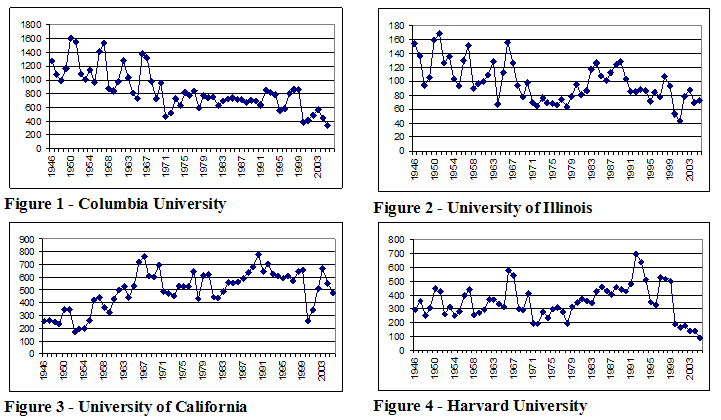Trajectories
Back to Table of Contents | Back to FindingsKey Points
- Private universities have 63% greater total news mentions and 57% greater front page appearances than public institutions. However, when limiting to just news coverage about institutions (excluding soundbites), roughly 24% of public institution coverage and 29% of private institution coverage is about the university.
Discussion
There is significant variation in the volume of coverage each institution has received in the New York Times over the past 60 years. Columbia University and New York University, both private institutions in the city itself, take the top two slots, with more than 40,000 articles each. The University of California system, with its nine campuses, is the only public institution to break the top nine, and has a little more than half the volume of Columbia University, despite having nearly seven and a half times the number of students. Universities also have different trajectories over time, with some undergoing steeper declines in coverage than their peers, while others have increased their coverage. View All Profiles.
The 87 public research extensive universities have had a grand total of 209,478 news and 11,662 front page articles mention them during this period, while the 48 private institutions have had 341,423 news and 18,328 front page mentions. Private schools enjoy a substantial advantage in New York Times coverage, with 63% greater total news mentions and 57% greater front page exposure. There is no appreciable difference in the percentage of news about public and private institutions, with 24% of news mentioning public institutions being about those institutions (7% of front page news) and 29% about privates (6% of front page news).
Institutional Profiles
Each institution tends to have a unique trajectory or "media signature" over the last 60 years. View our Interactive Profiles tool to see your school's media signature and compare it with others.

Correlations
Four categories of indicators are explored to determine the factors having the greatest correlation with news coverage of an institution: geographic location, enrollment, budget, and research output. Given the high interdependence of many of these variables and the inability to fully define the likely environment of critical indicators, deriving a model for regression would likely yield misleading results. The sections below therefore instead offer descriptive statistics on the indicators with the greatest correlations with news volume, but do not attempt to derive causal relationships between them.


